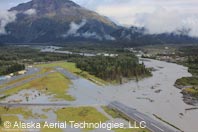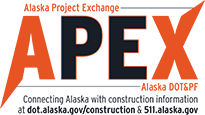Seward Airport Improvements Project
Project Purpose
The purpose of this project is to make improvements to the airport that will substantially reduce the damage the airport is experiencing from recurrent flooding and to meet FAA design standards based on current aircraft utilizing the airport and forecasted aviation needs. Currently, the runway lighting is old and needs replacement. Much of the pavement needs rehabilitation or replacement. Testing has revealed a weakened embankment under the pavement of Runway 13/31, necessitating a restriction of allowable aircraft weights to those under 12,500 pounds. Improvement of aging and deteriorating airport facilities is another major goal of this project.
The river delta adjacent to the airport has been rising relative to airport elevations, increasing the frequency and severity of overtopping floods. The main runway is now too low and in the direct path of the river, which has been repeatedly damaging it during high water events. Overtopping events were initially limited to the fall but have been occurring June through November in recent years, making maintaining the runway increasingly difficult. In response to multiple flood events during of the summer of 2013, DOT&PF constructed an emergency dike that is providing some temporary relief.
The most recent revision of the Federal Emergency Management Agency (FEMA) Flood Insurance Rate Map (FIRM) has now established a regulatory floodway across the existing main runway (RW 13/31) of the airport. By federal regulation, allowable construction is extremely limited in a regulatory floodway. DOT&PF completed a hydrologic study to help identify and evaluate feasible alternatives.
Three alternatives were evaluated during the scoping and environmental process. The current project scope corresponds to Alternative 2.2 in the approved Environmental Assessment. Alternative 2.2 had the most advantages and least number of disadvantages.
Click here for photos depicting flooding problems and other existing conditions.
 Seward
Airport Improvements Project (#54857)
Seward
Airport Improvements Project (#54857)Project Information
- Introduction
- Project Purpose
- Photos
- Project Schedule & Team
- Current Events
- Document Library
- Project FAQs
- Contact Us
Regional Links

Use DOT&PF's Alaska Project Exchange tools to learn more about all of DOT&PF's active construction projects statewide!
